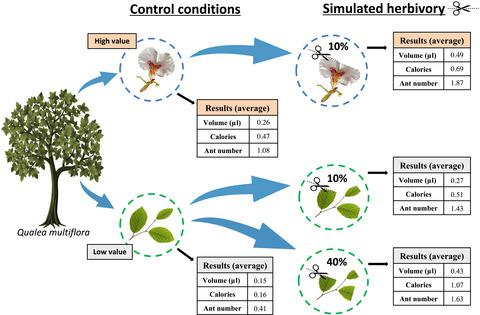Our official English website, www.x-mol.net, welcomes your
feedback! (Note: you will need to create a separate account there.)
Optimal Defense Theory in an ant–plant mutualism: Extrafloral nectar as an induced defence is maximized in the most valuable plant structures
Journal of Ecology ( IF 5.3 ) Pub Date : 2020-06-27 , DOI: 10.1111/1365-2745.13457 Eduardo Soares Calixto 1, 2 , Denise Lange 3 , Judith Bronstein 4 , Helena Maura Torezan‐Silingardi 2 , Kleber Del‐Claro 1, 2
中文翻译:

蚂蚁-植物共生中的最佳防御理论:在最有价值的植物结构中,作为诱导防御的花外花蜜被最大化
更新日期:2020-06-27
Journal of Ecology ( IF 5.3 ) Pub Date : 2020-06-27 , DOI: 10.1111/1365-2745.13457 Eduardo Soares Calixto 1, 2 , Denise Lange 3 , Judith Bronstein 4 , Helena Maura Torezan‐Silingardi 2 , Kleber Del‐Claro 1, 2
Affiliation

|
- Plants allocate defences in order to decrease costs and maximize benefits against herbivores. The Optimal Defense Theory (ODT) predicts that continuously expressed (i.e. constitutive) defences are expected in structures of high value, whereas defences that are expressed or that increase their expression only after damage or upon risk of damage (i.e. induced defences) are expected in structures of low value. Although there are several studies evaluating ODT predictions, few studies have successfully tested them as a way of measuring ecological investment in extrafloral nectary (EFN)‐mediated ant–plant interactions.
- Here we compared extrafloral nectar production and ant attractiveness to EFNs located on vegetative versus reproductive plant structures on Qualea multiflora plants subjected to different levels of simulated herbivory. We then addressed the following predictions emerging from the ODT: (a) extrafloral nectar produced in inflorescence EFNs will have higher volumes and calories and will attract more ants than extrafloral nectar produced in leaf EFNs; (b) extrafloral nectar production (volume and calories) and ant attendance will increase after simulated herbivory in leaf EFNs but not in inflorescence EFNs; (c) higher simulated leaf herbivory will induce higher extrafloral nectar production in EFNs on leaves and (d) more attractive extrafloral nectar (higher volume and calories) will attract more ants.
- Extrafloral nectar volume and calorie content, as well as ant abundance, were higher in EFNs of inflorescences compared to EFNs of leaves both before and after simulated herbivory, consistent with one of our predictions. However, EFNs on both leaves and inflorescences, not on leaves only, were induced by simulated herbivory, a pattern opposite to our prediction. Plants subjected to higher levels of leaf damage produced more and higher calorie extrafloral nectar, but showed similar ant abundance. Finally, more attractive extrafloral nectar attracted more ants.
- Synthesis. Our results show that extrafloral nectar production before and after simulated herbivory, as well as ant recruitment, varies according to the plant structure on which EFNs are located. Our study is the first to show that ant recruitment via extrafloral nectar follows predictions from Optimal Defense Theory, and that the ant foraging patterns may be shaped by the plant part attacked and the level of damage it receives.
中文翻译:

蚂蚁-植物共生中的最佳防御理论:在最有价值的植物结构中,作为诱导防御的花外花蜜被最大化
- 植物分配防御措施以降低成本并最大程度地提高对草食动物的利益。最佳防御理论(ODT)预测,在高价值结构中预期会出现连续表达的(即本构性)防御,而在防御中或仅在遭受损坏或遭受损坏的风险(即诱导防御)后才表达或增加其表达。低价值的结构。尽管有数项研究评估ODT预测,但很少有研究成功地对其进行测试,以此作为衡量在花蜜(EFN)介导的蚂蚁-植物相互作用中进行生态投资的一种方法。
- 在这里,我们比较了不同营养水平的草食动物在Qualea multiflora植物上营养和生殖植物结构上的EFN的花外花蜜产生和蚂蚁吸引力。然后,我们针对ODT提出了以下预测:(a)花序EFN中产生的花外花蜜比叶EFN中产生的花外花蜜具有更高的体积和卡路里,并且会吸引更多的蚂蚁;(b)在叶片EFN中模拟除草后,花序EFN中的花外花蜜产量(数量和卡路里)和蚂蚁出席率将增加;(c)较高的模拟叶片草食性将在叶片上的EFN中诱导较高的花外花蜜产生,并且(d)更具吸引力的花外花蜜(较高的体积和卡路里)将吸引更多的蚂蚁。
- 在模拟食草之前和之后,花序的EFN的叶外花蜜量和卡路里含量以及蚂蚁丰度均高于叶片的EFN,这与我们的预测之一一致。然而,叶和花序上的EFNs,而不仅是叶上的EFNs是由模拟草食动物诱导的,与我们的预测相反。遭受更高水平的叶片伤害的植物产生更多,更高卡路里的花外花蜜,但显示出相似的蚂蚁丰度。最后,更吸引人的花蜜吸引了更多的蚂蚁。
- 综合。我们的结果表明,模拟草食动物前后的花外花蜜产生以及蚂蚁的募集会根据EFN所处的植物结构而变化。我们的研究首次表明,通过花外花蜜招募蚂蚁遵循最佳防御理论的预测,并且蚂蚁的觅食模式可能受所侵害的植物部位及其受到的伤害程度的影响。











































 京公网安备 11010802027423号
京公网安备 11010802027423号